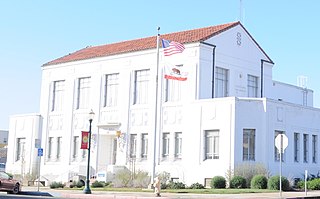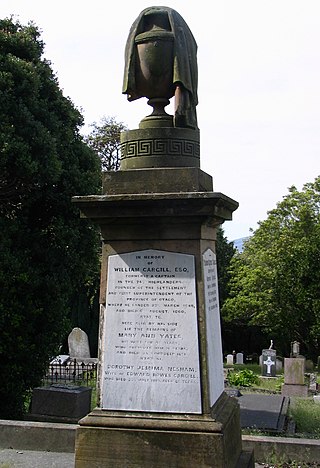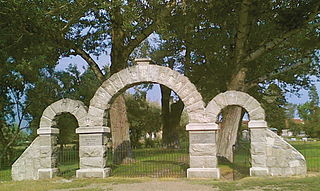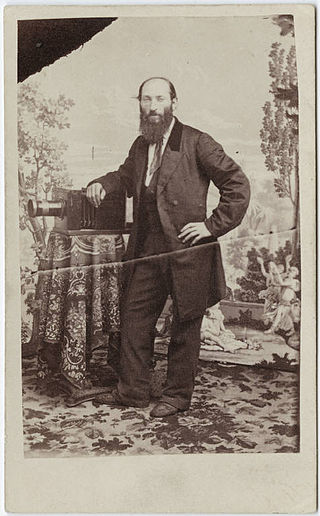
Marysville is a city and the county seat of Yuba County, California, located in the Gold Country region of Northern California. As of the 2010 United States Census, the population was 12,072, reflecting a decrease of 196 from the 12,268 counted in the 2000 Census. It is part of the Yuba-Sutter area of Greater Sacramento.

The Gold Country is a historic region in the northern portion of the U.S. state of California, that is primarily on the western slope of the Sierra Nevada. It is famed for the mineral deposits and gold mines that attracted waves of immigrants, known as the 49ers, during the 1849 California Gold Rush.

Oakland Cemetery is one of the largest cemetery green spaces in Atlanta, Georgia, U.S. Founded as Atlanta Cemetery in 1850 on six acres (2.4 hectares) of land southeast of the city, it was renamed in 1872 to reflect the large number of oak and magnolia trees growing in the area. By that time, the city had grown and the cemetery had enlarged correspondingly to the current 48 acres (190,000 m2). Since then, Atlanta has continued to expand so that the cemetery is now located in the center of the city. Oakland is an excellent example of a Victorian-style cemetery, and reflects the "garden cemetery" movement started and exemplified by Mount Auburn Cemetery in Massachusetts.

Mount Moriah Cemetery on Mount Moriah in Deadwood, Lawrence County, South Dakota is the burial place of Wild Bill Hickok, Calamity Jane, Seth Bullock and other notable figures of the Wild West. By tradition, the American flag flies over the cemetery 24 hours a day, rather than merely from sunrise to sunset.

A Jewish cemetery is a cemetery where Jews are buried in keeping with Jewish tradition. Cemeteries are referred to in several different ways in Hebrew, including beit kevarot, beit almin or beit olam [haba],, the beit chayyim and beit shalom.

The Southern Cemetery in the New Zealand city of Dunedin was the first major cemetery to be opened in the city. The cemetery was opened in 1858, ten years after the founding of the city in an area known as Little Paisley. This area lies at the southern end of Princes Street, one of the city's main streets, close to the suburbs of Kensington, Maryhill, and The Glen.
In the United States, Canada, Australia, and elsewhere, a pioneer cemetery is a cemetery that is the burial place for pioneers. American pioneers founded such cemeteries during territorial expansion of the United States, with founding dates spanning, at least, from the late 18th to early 20th centuries.

Home of Peace is a Jewish cemetery in Helena, Montana, founded in 1867 by the local Hebrew Benevolent Society, which formed on December 9, 1866. The Society formally purchased the land in 1875. The Home of Peace Cemetery Association now maintains the grounds. It is the oldest active cemetery in Helena and the oldest active European ethno-religious cemetery in Montana. There are three major sections of land owned by the Association: the cemetery, undeveloped adjacent land, and land leased to the Helena School District since 1975. The portion leased by the school district is a practice football field for Capital High School and contains unmarked graves from the earliest days of the cemetery. The original wrought iron fence erected in 1867 still stands except on the north side and is in disrepair in places. A granite gateway erected in 1910 is at the main entrance. The east gate also has granite markers. There is a water tower, pump house, and landscaping shed. Twelve broken tombstones lie at the base of the water tower. The northwest corner has remained undeveloped and in its natural wild state. In 1910 cottonwood trees were planted along the driveway.

Edward Abraham Kusel (1824-1907) was an American photographer and merchant. Born in Prussia, Kusel immigrated to the United States during the California Gold Rush. He eventually arrived in California, in 1852, making him one of the first Jewish settlers in the state. During his time as a merchant, he imported one of the first sewing machines into California. In 1859, he founded his photography studio, where he developed scientifically-based photography methods to improve early portrait photography. Kusel is considered a pioneer of the town of Oroville, California, where he served as a school board trustee for thirty years, built the first schoolhouse in the town, and donated a founding collection of books to the Oroville Public Library.

The Sonora Hebrew Cemetery, also known as Pioneer Jewish Cemetery, is an inactive Jewish cemetery founded in c. 1851, and located in Sonora, California. This was the first Jewish cemetery in the Gold Rush region.
Marysville Hebrew Cemetery also known as Marysville Jewish Cemetery, and Jewish Cemetery of Marysville, is a no longer active Jewish cemetery founded in 1855 by the Marysville Hebrew Benevolent Society, and is located at the southeast corner of Marysville Cemetery, in Marysville, California. In 1945, the cemetery was abandoned and forgotten; by 1995 it was restored.

Lone Mountain Cemetery was a complex of cemeteries in the Lone Mountain neighborhood of San Francisco, California, United States on the land bounded by the present-day California Street, Geary Boulevard, Parker Avenue, and Presidio Avenue. Opened 1854, it eventually comprised Laurel Hill Cemetery, Calvary Cemetery, the Masonic Cemetery, and Odd Fellows Cemetery.
Nevada City Jewish Cemetery is a no longer active Jewish cemetery founded in 1854 by the Nevada Hebrew Society, and located in Nevada City, Nevada County, California. The last burial was during the summer of 1890. There are only 29 headstones that are visible. On October 29, 1972, the site was dedicated as a historical site.
Jackson Pioneer Jewish Cemetery, also known as Givoth Olam, is a no longer active Jewish cemetery founded in 1857 by the Congregation B'nai Israel, and is located in Jackson, Amador County, California. By 1921, the cemetery was closed.
Chevra Kaddisha Cemetery, later known as Home of Peace Cemetery, was the first Jewish cemetery in California founded on November 12, 1850, by the Sacramento City Hebrew Association, and was once located at 33rd at K Streets in the East Sacramento neighborhood of Sacramento, California. The cemetery closed around 1924, and is no longer standing. It is the location of a strip mall, there is no historical plaque.
New Helvetia Cemetery, initially named Sutter Fort Burying Ground, is a defunct cemetery founded in c. 1845 and closed in 1912, formerly located at northeast corner of Alhambra Boulevard and J Street in the East Sacramento neighborhood of Sacramento, California. It was the first cemetery in the city of Sacramento.
The Home of Peace Cemetery is a Jewish cemetery founded in 1924, and located at 6200 Stockton Boulevard in Sacramento, California. This cemetery contains some of the earliest Jewish gravestones in the western United States, moved from Chevra Kaddisha Cemetery.
Grass Valley Pioneer Jewish Cemetery, also known as Shaar Zedek is a no longer active Jewish cemetery founded in 1856 by the Hebrew Benevolent of Society of Grass Valley, and is located in Grass Valley, California, U.S. The last burial happened in 1891. It is a private site operated by the Commission for the Preservation of Pioneer Jewish Cemeteries and Landmarks in the West and is not open to the public.
Placerville Pioneer Jewish Cemetery is a no longer active Jewish cemetery founded in 1854 by the Placerville Hebrew Benevolent Society, and is located in Placerville, California. The last burial happened in 1968. It is a private site operated by the Commission for the Preservation of Pioneer Jewish Cemeteries and Landmarks in the West and is not open to the public.










